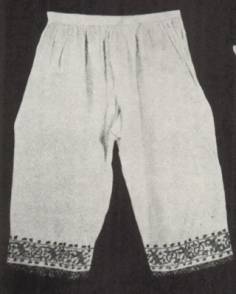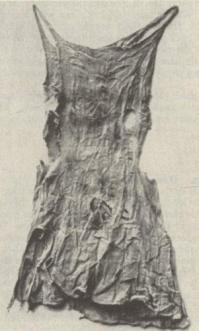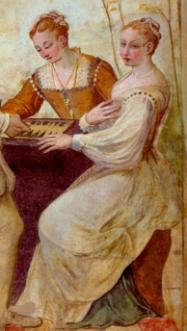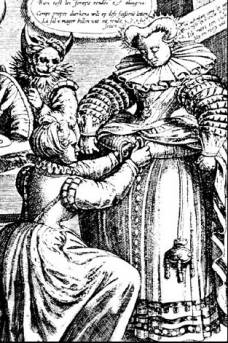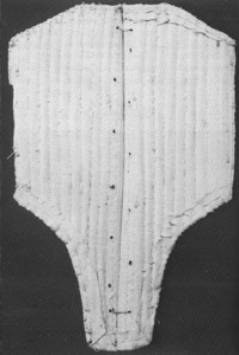The
Gruesome Truth About What Goes Underneath!
It’s
all about comfort.
Presented
By Mistress Oonagh O’Neill OL, 19 September 2004
We
all know what a Scotsman wears under his kilt, right? Socks!
But
what does a lady of the sixteenth century wear under her gown that gives that
shape, and comfort?
If
we want to take a from the skin out approach then we would be looking at a
staggering array of items:
|
Underpinnings
|
Then
the dress
|
Then
the accessories
|
|
v
Stocking
v
Draws
v
Slips
v
Underskirt
v
Bum
rolls
v
Farthingales
v
Corset
v
Chemise
v
Partlet
|
v
Dress:
as a single dress, or a separate skirt and bodice.
v
Sleeves
v
Jerkin
v
Doublets
v
Loose
gown
|
v
Shoes and
chopines
v
Pouches
& purses
v
Girdles
& belts, hand mirrors, fans, pomanders,
v
Miniatures
v
Books,
scissors, mirrors, needle cases, Muffs
v
Gloves,
rings, kerchiefs, flea catchers, bracelets
v
Dress jewellery,
brooches,
v
Ruffs
v
Pendants,
necklaces,
v
Partletts
& gollars
v
Hats, coifs,
hair jewellery; including false hair, hat jewellery, veils, circlets,
crowns, coronets
v
Earrings
v
Riding
masks, makeup and spectacles.
|
Underpinnings.
v
Stocking:
worn for warmth and for comfort with shoes.
They could be knitted as the Toledo ones are, or made of bias cut linen.
Garters in the form of long strips of fabric are needed to hold them up.
v
Draws:
worn for warmth and for comfort. Made
of linen as most undergarments were. These
were long in the leg and could be embellished bit embroidery and lace.
Front fastening with either a button, hook and eye of a tie.
v
Slips:
worn under the corset to protect the corset form body grease, and for personal
comfort. Because
the chemise or carmicia is worn over the corset there should be something against
the skin for the wearers comfort and to protect the corset.
I now believe that this was not exclusive to the Venetian dress code.
v
Underskirt:
worn for warmth and to help protect your valuable skirts from the dirt of the
streets. Some dress codes only
require an underskirt to be worn under the skirt.
NO bum-rolls or farthingales required.
v
Bum-rolls:
one of the extremes of body sculpture of the sixteenth century.
This padded sausage like item helps to hold the shape at the waist and
hips of skirts seen in the English, French and Spanish styles.
v
Farthingales:
again not necessary with all sixteenth century styles. These give a distinctive bell silhouette to the skirts.
English, French and Spanish styles use this the most.
v
Corset:
the quintessential instrument of torture.
They
can be uncomfortable if they are not fitted properly, just like a bra can be.
With out a corset the silhouette will not be as it is in the portraits. The
only way to achieve that very flat front is with a corset.
v
Chemise:
these come in a variety of style that is a variation on a theme. Mid thigh to ankle length, long sleeved.
Open neck or high neck. Cuffs
or open sleeves. Generally linen
again, occasionally silk, infrequently cotton, as this was less available as it
is today. Drawstrings are not
obvious, but are very useful for our purposes in the SCA.
Embellishments of embroidery, usually monochrome are frequently seen.
Lace trim in white, black and occasionally gold thread us used in the
lace.
v
Partlet:
this is an optionally item of dress.
Sometimes the wearing of one was associated with your marital status.
That is dependant on your geographic location as much as anything.
I would consider wearing a partlet under a doublet an essential.
A variety of variations on this exist also.
They could be as simple as a scarf folded on the bias and pined in at the
neck opening, or fully structured with a collar and ruff.
This one little item of underpinnings could be made almost as ornate as
you liked. Beading, embroidery,
lace, couching go nuts on this.
Points
to Remember.
Whilst
many items of dress are common to many regions during the sixteenth century, a
key term to remember is ‘regional differences’.
The
custom of wearing an item of dress may differ significantly from region to
region, and time frame to time frame. What
is acceptable in Italy may not be acceptable in Spain for example.
The partlet is one such example. Worn
closed in England by a married lady, and open if the lady is single.
No such protocol seems to exist in Venice at the same time.
The
construction of items of dress while similar is also a regional concern.
The base undergarment of a Chemise would appear to be generic in its
nature. To some extent this can be
true. When looking closer at this
item there are some variations that are peculiar to a region.
Some chemise have a high neck while others are open necked and use a
partlet for this look.
Embellishment
also differs dependant on region. The
style of blackwork on an English smock will most often be different to that of a
French Chemise. Lace generally does not appear on a German chemise while the
Venetians loved this lavish trim.
These
undergarments whilst they may seen to be surplus to requirement, do add a level
of comfort and shaping to the finished dress that would otherwise be missed.
Trust me, I questioned the comfort factor when I began, but I don’t any
more, they knew what they were doing.
Social
status is also an indicator by which the level of your dress is determined.
In the SCA we are all presumed to be at minimum minor nobility. When we start our skills are not at their peak so it is safe
to think of this as the beginning of our journey in social standings also.
As our skills develop this show through what we wear, just as some one
would have done when climbing the social ladder in the time we are choosing to
recreate.
Fabric
choices. Linen is the big one; this
is the most document able textile for pre 1600 under dressing.
Linen is also the most practical for our climate in Australia.
Silk is the most luscious and the warmest textile.
Cotton while less frequent in pre 1600 is probably the most cost
effective for most of us. Synthetics and synthetic blends should be avoided as they
don’t breath and often don’t look right.
My
biggest recommendation for those wanting to get the ‘Look’ right, buy a
mirror. Look at the portrait that
originally inspired you and then look at yourself critically in the mirror.
Look at the shapes and silhouette you are creating, and then look at what
is in the portraits. You will learn
a lot by doing this.
I
have not included construction notes in this collegium.
Rather this is a separate lesson that should concentrate on each item of
undergarment in its turn at a later date. To
try to do this in an introduction would not do justice to the various items of
dress and key points could be missed.
Bibliography
Alcega,
Juan de. Tailor's Pattern Book 1589. Trans. Jean Pain and Cecilia Bainton.
Carlton, Bedford, UK: Ruth Bean, 1979.
Arnold,
Janet. Patterns of Fashion: The Cut and Construction of Clothes for Men and
Women 1560-1620. New York:
Drama Books, 1985
Harris
Jennifer. 5000 Years of Textiles, British Museum Press in association
with The Withworth Art Gallery and The Victoria and Albert Museum 1993
Kohler
C, A History of Costume, New York Dover 1963,
Marinis,
Fabrizio De (editor) Velvet; History, Techniques, Fashions, Idea Books
New York 1994
Ricci
E. Italian Lace Designs 243 Classic Examples New York Dover 1993
Vecellio,
Cesare, Vecellio's Renaissance Costume Book, Dover Publications,NY, 1977.
Vinciolo
F. Renaissance Pattern For Lace, Embroidery and Needlepoint: An unabridged
Facimile Of The ‘Singuliers et nouveaux pourtraicts’ of 1587 New York:
Dover 1971
Weiditz,
Authentic Everyday dress of the Renaissance, (Trachtenbuch) New York
Dover 1994.
Willet,
C. & Cunnington, Phillis, A History of Underclothes, New York Dover
1992,
Web
pages that might be of help.
Drea Leed http://costume.dm.net
Festive
Attyre http://homepage.mac.com/festive_attyre
Lady
Katerina da Brescia’s home page http://home.iprimus.com.au/adeptus/kat/
Kas McGann http://www.reconstructinghistory.com/beginners/chemise.html
Marc
Carlson's: Some Clothing of the Middle Ages. www.personal.utulsa.edu/~marc-carlson/cloth/hose.html
Modern
History Sourcebook: William Harrison (1534-1593): Description Of Elizabethan
England, 1577 from Holinshed's Chronicles) http://www.fordham.edu/halsall/mod/1577harrison-england.html
Oonagh’s
Own: Gruesome Truth http://www.oocities.org/technically_naked
(yours
truly)
V&A
Museum website http://images.vam.co.uk/ixbin/hixclient/exe?
Back
Email
Home
All
intellectual content, composition, layout, designs and photographs, unless
otherwise noted are copyright 2007 to Deborah
Lane ©,
or, copyright 2003 to Deborah Murray
©
also known as Mistress Oonagh O'Neill ©.
All Original renaissance art works and artefacts are not copyright to Deborah
Murray, and are shown for educational use only . If you see something
you'd really like to use, please contact
me!


